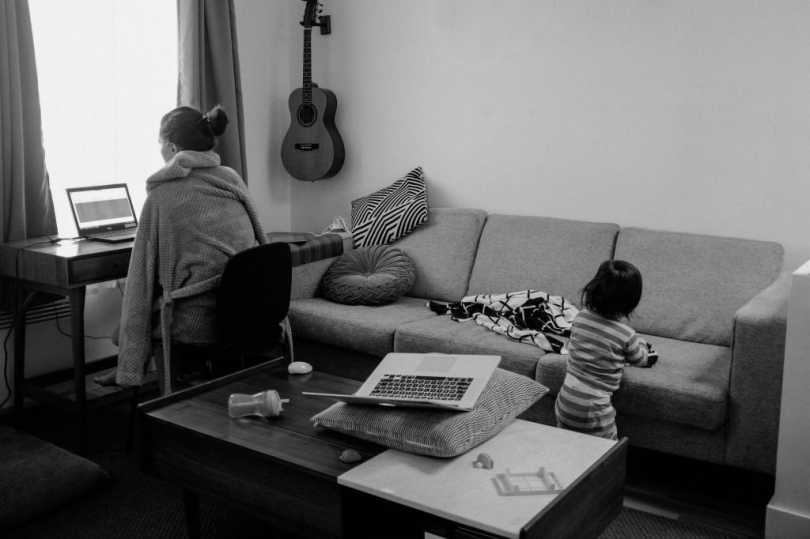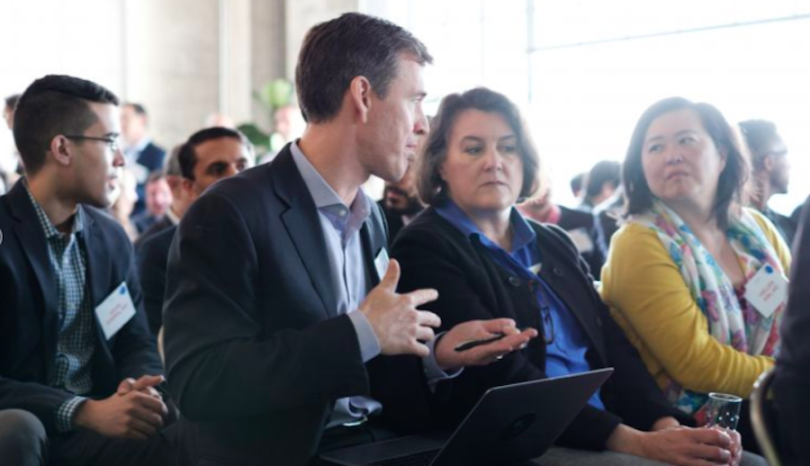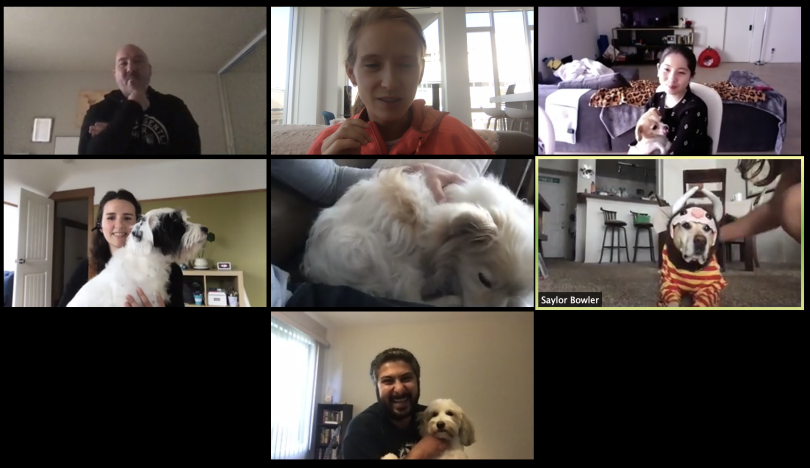“A remote culture is fundamentally a writing culture.”
When it comes to fostering collaboration between engineering and product, Engineering Manager Jack Noble said nothing beats clear, expressive writing, especially while remote. So much so, in fact, that at healthtech company Doximity, Noble asks direct reports to submit technical proposals using journalism’s inverted pyramid model. That way, readers get the most important information first.
The strategy is one of many that has replaced physical whiteboarding and in-person, group collaboration as product and engineering professionals acclimate to brainstorming and problem-solving from their homes. The following four tech managers and directors rely on software programs like InVision Freehand, Figma and Retrium to ease the transition and bridge knowledge gaps.
But even the most common tools come with a learning curve –– and a few house orders.
“As we’re workshopping through ideas and feedback, Figma allows us to riff and whip up new wireframes or designs together,” Digit Product Manager Eric Brownrout said. “We have an important rule, though: no stalking designers in Figma while they’re doing their thing!”

In the office, Product Manager Eric Brownrout’s team at Digit prints and hangs wireframes around the space to show their work in progress and get feedback from colleagues. Because that’s not a possibility in a remote environment, PMs, engineers and designers have instead been using software like InVision Freehand and Figma. Brownrout said that Figma is a great collaboration tool, allowing team members to whip up new wireframes or designs together while apart.
In the office, whiteboarding sessions and sticky notes help product and engineering teams brainstorm, plan and visualize their ideas. Now that everyone is remote, how are you adapting these types of meetings?
Digit is a whiteboard-heavy company when we are together in the office, so there has been a learning curve to moving fully remote. A few tools have made the transition that much more pleasant.
For jamming on product ideas and new designs, we use InVision Freehand and Figma. InVision Freehand has been helpful early in the product development cycle when we want to collect a bunch of ideas in one place and jointly jam on sketches, user flows, wireframes and more. It’s even better with a Miro or an iPad and it has collaborative editing features that can make it more convenient than its analog sibling. As we move deeper into the design process, Figma is essential to our workflow. Figma allows PMs, engineers and fellow designers to drop into any project in real time to get a sense of where we are. We have an important rule, though: no stalking designers in Figma while they’re doing their thing!
We’re also big believers in retrospectives. TeamRetro has brought the magic of retros to the remote world. We use the prioritization and time-management features to keep discussions focused before capturing action items and the next steps in line.
Lastly, a few of us on the product team are big fans of Whimsical as a sort of wundertool. Its ease-of-use and ability to pump out high-quality diagrams and charts make it powerful and fun. I frequently use Whimsical to create assets for product specs and strategy documents.
For jamming on product ideas and new designs, we use InVision Freehand and Figma.’’
How are your product and engineering teams communicating differently now that everyone is remote, and why?
We’ve always used Slack, but Slack etiquette has become much more important now. As the team grows and we spin up new projects, we’ve seen some issues pop up. For instance, we were creating new channels left and right. They were difficult to discover and sometimes even duplicative. For new hires, it was a nightmare getting plugged into all the right conversations. So we put together internal Slack guidelines that outline best practices for creating and naming channels, tips to use Slack like a pro (use @here and @channel sparingly), and a running Wiki of our most important channels and their purposes.
We also recently transitioned to Jira Cloud. Jira’s Slack integration is one of the most helpful features for improved communication. We’ve set up #notify channels for each project to capture key Jira ticket status changes (created, in-progress, done) that have helped me have better visibility into what’s in flight.
Additionally, we found that live discussions, especially over Zoom, were sometimes going down a rabbit hole or bouncing around incoherently. So now, we collect all clarifying questions and feedback before or at the beginning of the meeting. That way, the meeting owner has a full view on what topics are top of mind for the group and can effectively steer the meeting.
What’s the most important practice your team follows to ensure successful remote collaboration between your product and engineering teams?
As we switched to fully remote, we lost the luxury of being able to stop by each other’s desks to say a quick “hello” or provide an update. So people’s calendars were filling up. To protect our heads-down time across engineering, design and product, we’ve enforced a “no meetings on Wednesdays” policy. There are fewer things more draining than a full day of back-to-back Zoom meetings. This protected time once a week is a much-needed reprieve to recharge and knock out whatever spec, design or development you haven’t been able to get to between meetings.
We’ve also converted certain asynchronous practices in light of remote work. For instance, in the office, we almost exclusively used Standuply to do async stand-ups in Slack for our product development teams. In a remote environment, we’ve switched to live stand-ups three times a week. This shift has been helpful because our most pressing updates or blockers aren’t lost in the ether of Slack and, perhaps more importantly, we have a chance to see each other and catch up.

Because Abishek Rajendra understands that having several hours of Zoom calls per day can be mentally and emotionally draining, the director of organic growth at Course Hero said he tries to maximize efficiency by sharing agendas and outlines in advance of meetings. This allows team members who want to gather information ahead of time to do so. According to Rajendra, clear and intentional communication is the most important aspect of a remote team’s success.
Now that everyone is remote, how are you adapting meetings?
We generally brainstorm or sprint plan on-site using a whiteboard and some sticky notes. When the entire team is working from home, you need to rely on online tools for collaboration. We frequently use Retrium for brainstorming, Zoom and Slack for whiteboarding, Confluence and Google Docs to share in-depth analysis, and Jira for project management. Using a combination of these tools in unison makes remote collaboration a breeze.
How are your product and engineering teams communicating differently now that everyone is remote, and why?
During the last several months, product and engineering teams have made significant efforts to communicate effectively and efficiently by managing expectations during virtual team meetings. Visual cues are harder to pick up on when you’re running team meetings via Zoom. When possible, we recommend all meeting participants turn on their camera.
We ask those running virtual meetings to outline a clear agenda and try to keep the energy and pace of the meeting up. If needed, we recommend they follow up with disengaged employees after the meeting. And above all, we ask that managers be patient with themselves and their team. Not everyone is suited to remote work.
Above all, we ask that managers be patient with themselves and their team.’’
What’s the most important practice your team follows to ensure successful remote collaboration between your product and engineering teams?
Our daily team stand-up has become even more important to us in a remote setting. This short, daily meeting includes product and engineering employees. It allows us to communicate with everyone at least once a day while encouraging positive team building and collaboration. We try to reduce roadblocks and improve our understanding of shared goals.

Whether your team is distributed or not, Doximity Engineering Manager Jack Noble recommends building a culture of asynchronous, written discussion. He touts its productivity benefits, explaining that engineers can participate in discussions without interrupting focused work. Additionally, more people can comment on a written proposal than can participate in an in-person meeting.
Now that everyone is remote, how are you adapting meetings?
Before shelter-in-place orders, Doximity’s engineering team was already 70 percent remote. So we’ve had a big head start at building a remote culture. Virtual whiteboards and sticky note web apps help, but nothing beats clear, expressive writing. Once teammates are in different time zones or occasionally dealing with unexpected interruptions at home, debates and decisions will have to start happening asynchronously. A remote culture is fundamentally a writing culture.
At Doximity, large product changes start with simple needs-assessment documents. We clearly and simply state the problem that needs to be solved and solicit ideas and solutions. Then, we develop ideas into longer product and technical proposals before breaking up the work into individual tickets. Proposals shouldn’t be preachy or long-winded. We borrow the inverted pyramid model from journalism to ensure the proposed readers get the most important information first. From there, they can decide whether or not they need to get into the weeds. For faster, more informal coordination, we rely on Slack.
At Doximity, large product changes start with simple needs-assessment documents.’’
How are your product and engineering teams communicating differently now that everyone is remote, and why?
The biggest change for us is our quarterly in-person off-sites. These off-sites are a chance for the team to have fun, build friendships, plan and brainstorm for the next quarter’s work. It’s also a time for creative cross-pollination. Picture an engineer and a product manager in front of a campfire taking a breath to reconsider assumptions and dream about the product outside the normal development cycle.
Our substitute, until it’s safe to travel, are Zoom brainstorms and unstructured small-group conversations. We’re also striving to create these moments more frequently than once a quarter. We know we’re not going to find ourselves near a campfire any time soon, so we’re being intentional about making the most of a remote setting.
What’s the most important practice your team follows to ensure successful remote collaboration between your product and engineering teams?
Practices and procedures will always change as teams scale or shift focus. What matters most is ensuring engineering and product departments share values and incentives. The product development process shouldn’t be a tug of war over scope, deadlines and technical debt.
Rather, planning ought to be a collaboration between experts. Product professionals should encourage time spent on technical debt to ensure prompt delivery on future projects and engineering professionals should be motivated to add business value whenever possible.

Product Manager Sameer Advani said the Nylas product and engineering teams communicate more now that they are remote than they did in the office. Stand-ups allow product professionals to touch base with their engineering counterparts daily. The team also sends weekly product updates to the entire company.
Now that everyone is remote, how are you adapting meetings?
Nylas has always been ready for remote work. We are a globally distributed team. We use a combination of tools: Zoom, Slack, Linear, Notion, Google Docs, Dropbox Paper, Clubhouse and Miro. We have all our meetings on Zoom. All our non-meeting communication is on Slack. During meetings, most note-taking happens on Google Docs.
For sprint planning sessions, we write out a one-pager that talks to the business value of the initiative in question. We then set up a kick-off Zoom call with all the cross-functional stakeholders to walk through the one-pager. We add any risks or blockers identified during the call in Dropbox Paper and tag the relevant people. Once there is alignment, we write user stories in Clubhouse and assign them to the relevant teams.
We communicate a lot more now that we are remote.’’
How are your product and engineering teams communicating differently now that everyone is remote, and why?
We communicate a lot more now that we are remote. One of the biggest challenges with being remote is the lack of spontaneous social interactions that typically happen in an office setting. To recreate this, the first 10 or 15 minutes of our stand-ups are freeform. I love this part of my day.
What’s the most important practice your team follows to ensure successful remote collaboration between your product and engineering teams?
There are currently three of us on the product team. We have daily stand-ups with our respective engineering teams and then daily stand-ups with each other. We also send weekly product updates to the entire company. They cover strategy, ongoing research, and ongoing epics per team. This type of communication ensures that there is full transparency across the company at all levels. If folks have questions, they can simply go to Slack to get them answered.







